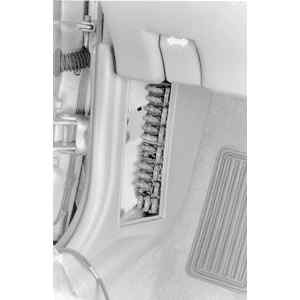It is possible for large surges of current to pass through the electrical system
of your vehicle. If this surge of current were to reach the load in the circuit,
the surge could burn it out or severely damage it. It can also overload the
wiring, causing the harness to get hot and melt the insulation. To prevent this,
fuses, circuit breakers and/or fusible links are connected into the supply wires
of the electrical system. These items are nothing more than a built-in weak
spot in the system. When an abnormal amount of current flows through the system,
these protective devices work as follows to protect the circuit:
- Fuse — when an excessive electrical current passes through
a fuse, the fuse "blows" (the conductor melts) and opens the circuit, preventing
the passage of current.
| Fig. 1: Most vehicles use one or more fuse panels.
This one is located on the driver's side kick panel

|
- Circuit Breaker — a circuit breaker is basically a self-repairing
fuse. It will open the circuit in the same fashion as a fuse, but when the
surge subsides, the circuit breaker can be reset and does not need replacement.
- Fusible Link — a fusible link (fuse link or main link) is
a short length of special, high temperature insulated wire that acts as a
fuse. When an excessive electrical current passes through a fusible link,
the thin gauge wire inside the link melts, creating an intentional open to
protect the circuit. To repair the circuit, the link must be replaced. Some
newer type fusible links are housed in plug-in modules, which are simply replaced
like a fuse, while older type fusible links must be cut and spliced if they
melt. Since this link is very early in the electrical path, it's the first
place to look if nothing on the vehicle works, yet the battery seems to be
charged and is properly connected.
CAUTION
Always replace fuses, circuit breakers and fusible links with identically rated
components. Under no circumstances should a component of higher or lower amperage
rating be substituted.

